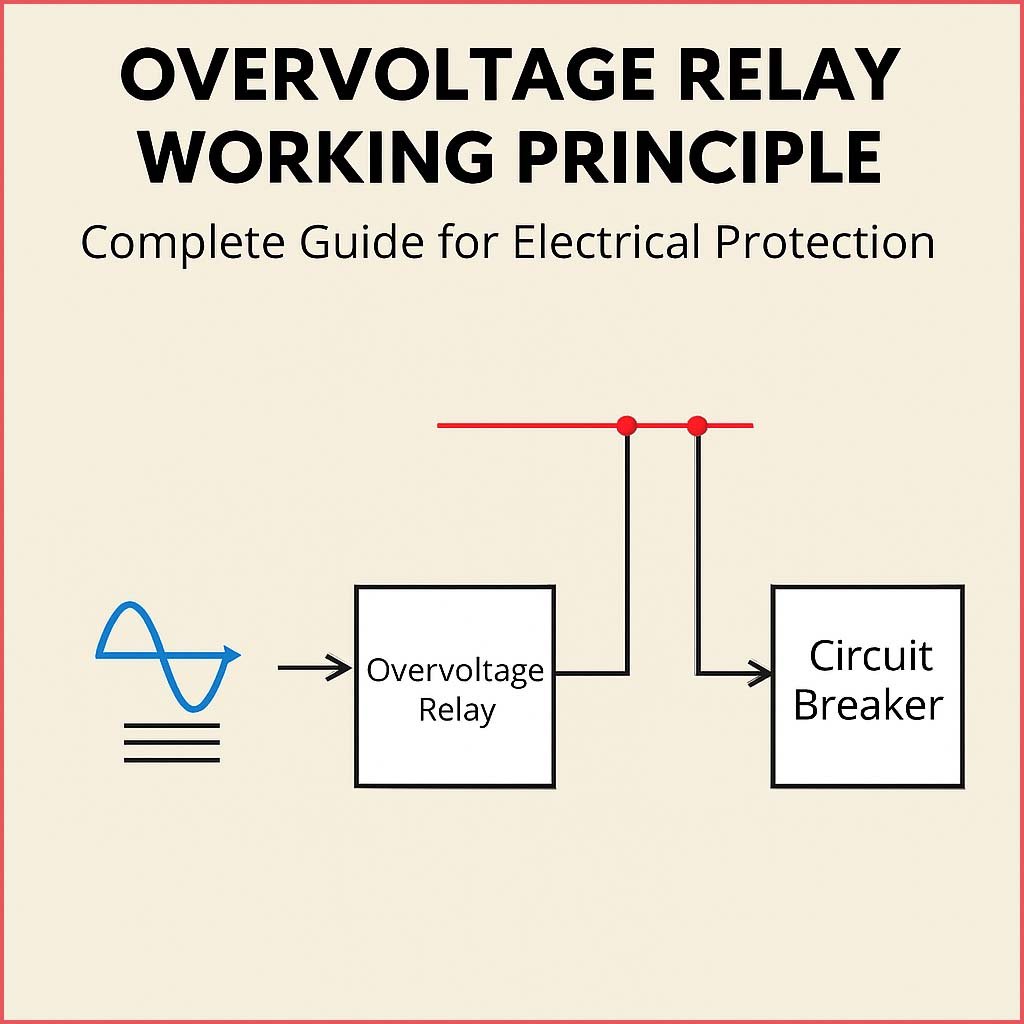Overvoltage Relay Working Principle: Complete Guide for Electrical Protection
Overvoltage relays are crucial components in electrical power systems. They protect equipment from voltage levels higher than the designed limits. These relays are commonly used in generators, transformers, transmission lines, and distribution systems to ensure the safety and stability of the electrical network. Understanding the overvoltage relay working principle helps engineers design safer and more reliable systems.

Table of Contents
What is an Overvoltage Relay?
An overvoltage relay is a protective device that detects excessive voltage in a power system and initiates corrective action. The main function is to prevent equipment damage caused by transient or sustained overvoltage conditions. Overvoltage can occur due to lightning, switching surges, or sudden load changes.
Key Functions:
- Detect abnormal voltage levels
- Trigger alarms or trip circuits
- Prevent insulation failure in equipment
- Ensure system stability
Learn in detail on vfd overload current setting
Types of Overvoltage Relays
Overvoltage relays are classified based on operating principles and construction. The most common types include:
| Type | Principle | Application |
|---|---|---|
| Electromagnetic | Coil movement caused by voltage | Generators, transformers |
| Static | Uses electronic circuits | Industrial power systems |
| Induction | Rotating disc due to voltage | Overhead transmission lines |
| Digital | Microprocessor-based | Smart grids, modern substations |
Working Principle of Overvoltage Relay
The overvoltage relay working principle is based on sensing the voltage level and activating a trip when the voltage exceeds the preset limit. The operation varies slightly depending on the relay type.
Electromagnetic Overvoltage Relay
In an electromagnetic relay, the relay coil is energized by the system voltage. When the voltage exceeds the set value, the magnetic field moves a plunger or armature, closing or opening contacts. This action triggers an alarm or isolates the faulty section. Dive deeper into differential protection of alternator
Basic formula for electromagnetic operation:

Where:
- (F_m) = Magnetic force on the armature
- (B) = Magnetic flux density
- (A) = Cross-sectional area of the coil
- (mu_0) = Permeability of free space
Static Overvoltage Relay
Static relays work without moving parts. They use electronic components like operational amplifiers, comparators, and transistors. The relay continuously monitors voltage. When the voltage crosses the threshold, the electronic circuit activates a trip signal.
Induction Type Overvoltage Relay
This relay uses a rotating aluminum disc. The disc is subjected to forces from the voltage-induced currents in the relay coils. Once the disc rotation exceeds a set limit, a contact closes to initiate tripping. Induction relays are highly reliable and widely used in high-voltage systems. Learn more about types of generator protection relays
Voltage Setting and Time-Delay
Overvoltage relays are usually equipped with adjustable settings. These include pickup voltage and time delay.
| Setting | Description |
|---|---|
| Pickup Voltage | Minimum voltage at which relay operates |
| Time Delay | Delay before the relay activates after detecting overvoltage |
Time delay prevents unnecessary tripping due to transient overvoltage. It ensures that the relay only responds to sustained abnormal conditions. The time delay (t) can be calculated using:

Where:
- (V_actual) = Actual system voltage
- (V_pickup) = Relay setting voltage
- (k, n) = Relay-specific constants
Applications of Overvoltage Relays
Overvoltage relays are used in various scenarios to protect electrical equipment.
- Generators: Prevents overvoltage during sudden load reduction
- Transformers: Protects winding insulation from voltage surges
- Transmission Lines: Guards against lightning and switching surges
- Industrial Loads: Ensures machinery is safe from abnormal voltages
Advantages of Using Overvoltage Relays
- Prevents damage to expensive equipment
- Reduces downtime due to electrical faults
- Enhances safety for personnel
- Provides reliable operation with minimal maintenance
Get complete information about protection of alternator
Installation Considerations
Proper installation is essential for the effective operation of overvoltage relays. Key points include:
- Mount the relay close to the equipment it protects
- Ensure accurate voltage sensing using potential transformers
- Use appropriate relay type based on system voltage and application
- Regular calibration to maintain accuracy
Common Problems and Troubleshooting
Even the best overvoltage relays can face operational issues. Some common problems include:
- Incorrect Settings: Relay may not operate correctly if the pickup voltage is set too high or too low
- Coil Burnout: Excessive voltage or poor maintenance may damage the coil in electromagnetic relays
- Electronic Failure: Static relays can fail due to component aging or overvoltage stress
- Contact Wear: Frequent tripping can cause mechanical contacts to degrade
Know more about alternator protection scheme
Maintenance Tips
To ensure long-term reliability:
- Periodically test relay operation
- Verify voltage settings and adjust if necessary
- Clean contacts and inspect for corrosion
- Check electronic circuits in static relays
Key Formulas Related to Overvoltage Relay
- Magnetic Force on Electromagnetic Relay:

- Time-Delay Equation:

- Voltage Ratio for PT Connection:

Where (V_PTratio}) is the potential transformer ratio used for measurement.
Explore details on IEC Standard for Differential Protection
Conclusion
The overvoltage relay working principle is fundamental in electrical protection systems. These relays safeguard critical equipment by detecting and responding to abnormal voltage conditions. Understanding the types, settings, working mechanism, and maintenance practices ensures reliable performance. Whether using electromagnetic, induction, or static relays, proper application of overvoltage relays protects the system from damage and enhances operational safety.
By following the principles outlined in this article, engineers can design efficient protection schemes that maintain system stability while minimizing unnecessary tripping. The integration of modern digital relays further improves reliability and precision in voltage monitoring and protection.
Find out more about transformer differential protection
Follow Us on Social:
Subscribe our Newsletter on Electrical Insights to get the latest updates in Electrical Engineering.
#OvervoltageRelay, #RelayWorkingPrinciple, #ElectricalProtection, #OvervoltageProtection, #PowerSystemSafety, #RelayGuide, #ElectricalEngineering, #IndustrialProtection, #VoltageSafety, #RelayOperation





